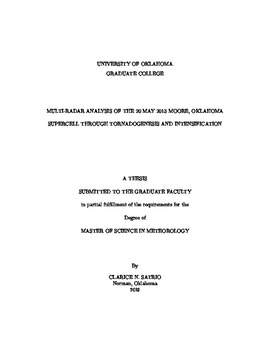| dc.description.abstract | On 20 May 2013, a violent, long-track EF-5 tornado impacted Moore, Oklahoma and surrounding areas, occurring within a network of radars operating in close proximity to the supercell. This network of radars consisted of three WSR-88Ds – KTLX, KOUN, and KCRI, in addition to the PX-1000, a rapid-scan, transportable, X-band radar with 20-s temporal resolution. This analysis focused on detailing polarimetric supercell attributes leading up to tornadogenesis and through tornado intensification. Two analyses were conducted to analyze in-storm processes within the supercell – high-spatiotemporal supercell evolution using PX-1000 and volumetric characteristics of ZDR and KDP signatures using KTLX and KOUN.
High-temporal observations from PX-1000 resolved three distinct rear-flank downdraft (RFD) surges, two of which occurred prior to tornadogenesis (1946:09 and 1952:27 UTC) and one coincident with tornadogenesis (1957:05 UTC). The RFD surges were characterized by transient intensifications in ΔV, an advancing ZH gradient wrapping cyclonically around the low-level mesocyclone, and a decrease in ρhv within the hook echo, likely resulting from the lofting of light debris from increased wind speeds. The second and third RFD surges are especially robust, with ΔV exceeding “tornado” threshold (> 40 m s-1) and detection of a tornado debris signature utilizing a hydrometeor classification algorithm. Patterns associated with the RFD surges suggests the possibility of brief, weak tornadoes occurring prior to tornadogenesis (1956 UTC), but ultimately resulting in the failure of the tornadoes to sustain themselves.
Trends in ZDR arc and KDP foot volumetric characteristics as well as ZDR and KDP columns are also documented using KTLX and KOUN. In the times leading up to tornadogenesis, while ZDR arc remained relatively shallow, KDP foot exhibited consolidation / deepening immediately downshear of the updraft, indicating increased likelihood of tornadogenesis. Additionally, prior to tornadogenesis, ZDR and KDP columns displayed a decrease in both depth and volumetric extent, signifying a weakening updraft as a result of a strengthening downward-directed perturbation pressure gradient force. Contrary to an overall weakening trend prior to tornadogenesis, column analysis detected an updraft pulse at ~1942 UTC. Lastly, the steady decrease in column strength shifts to rapid growth just before (5 – 10 min after) tornadogenesis for KDP (ZDR) column. | en_US |
